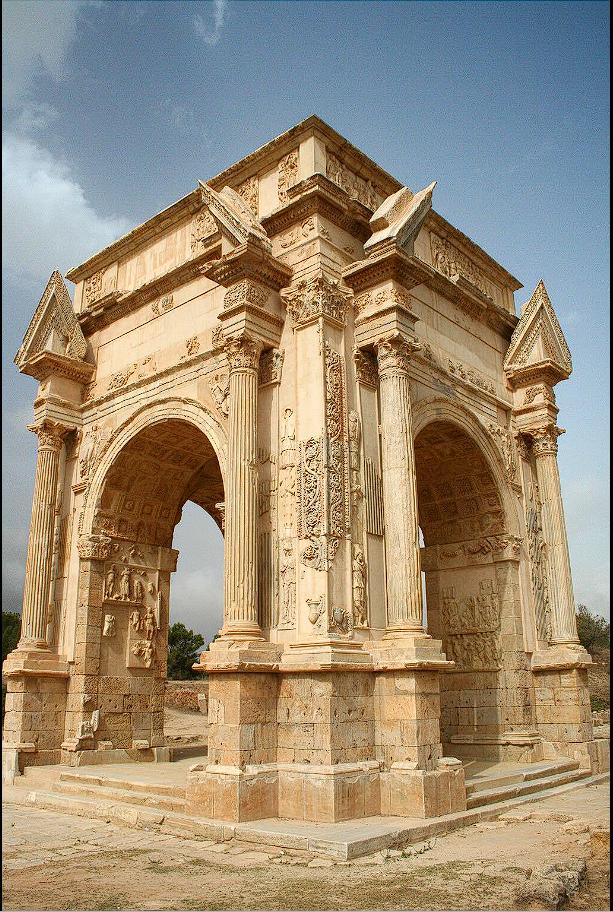Constructed around the dawn of the 3rd century AD, approximately in 203 AD, the magnificent Arch of Septimius Severus stands as an enduring and powerful testament to the formidable might of the Roman Empire and the ambitious legacy of its emperor, Lucius Septimius Severus. Strategically situated at a vital crossroads within the ancient city of Leptis Magna—a prominent urban center along the sun-drenched Mediterranean coast in what is now modern-day Libya—the arch served as a grand commemorative monument, celebrating Severus’s significant military triumphs and emphatically proclaiming the ascendant legacy of his imperial family. Positioned with deliberate intention at the very intersection of the city’s principal thoroughfares, the north-south axis of the cardo and the east-west trajectory of the decumanus, the arch was not merely an impressive architectural marvel; it functioned as a potent and highly visible symbol of the overarching imperial authority that emanated from Rome and extended across its vast territories.
A Quadrifrons Marvel: Limestone, Marble, and the Language of Power
This grand and imposing quadrifrons, or four-sided, triumphal arch soars to an impressive height of approximately 21 meters, a testament to the engineering prowess and artistic ambition of the Roman builders. Constructed from a combination of sturdy local limestone for its core structure and adorned with the more prestigious and visually striking marble for its facing and decorative elements, the arch was designed to command attention and inspire awe. Its architectural design is characterized by robust Corinthian columns strategically placed at each of its four corners, elevated upon substantial pedestals that further accentuate their grandeur. Niches, carefully integrated into the arch’s design, once housed statues, likely depicting members of the imperial family or revered Roman deities, further reinforcing the visual narrative of imperial power and divine favor. Each of the arch’s four distinct facades is lavishly adorned with intricate and deeply symbolic relief sculptures, portraying the imperial family in scenes of triumph and piety alongside various prominent Roman deities, meticulously celebrating both the earthly military achievements and the perceived divine sanction of Severus’s reign.
Leptis Magna: A Favored City and Imperial Roots
The choice of Leptis Magna as the location for such a significant triumphal arch was no accident. Septimius Severus was born in this prosperous North African city, elevating its status and ensuring its embellishment with significant imperial monuments. His patronage transformed Leptis Magna into one of the most magnificent cities in Roman Africa, a testament to his personal connection and imperial vision.
The Quadrifrons Design: Symbolism at a Crossroads
The quadrifrons design, with its four identical facades oriented towards the cardinal directions, was a less common but significant variation of the Roman triumphal arch. Its placement at the intersection of the cardo and decumanus ensured its visibility from all major axes of the city, symbolically projecting imperial power and presence to all corners of Leptis Magna.
Corinthian Order: Elegance and Imperial Grandeur
The use of the Corinthian order for the arch’s columns, characterized by its ornate capitals adorned with acanthus leaves, reflects the Roman Empire’s embrace of Hellenistic architectural styles to convey sophistication and imperial grandeur. The towering columns added to the arch’s imposing scale and visual impact.
Reliefs of Triumph and Divinity: A Visual Chronicle of Severan Rule
The intricate relief sculptures that adorn each facade of the Arch of Septimius Severus served as a powerful form of imperial propaganda, visually narrating the key events and ideologies of Severus’s reign. These detailed carvings depicted scenes of military victories, such as his campaigns in Parthia, showcasing Roman military might and the emperor’s leadership. Alongside these earthly triumphs, the reliefs also featured depictions of Roman deities, emphasizing the divine favor bestowed upon Severus and his family, legitimizing their rule and associating them with the traditional Roman pantheon. The presence of the imperial family within these scenes, often depicted in positions of power and piety, further reinforced their authority and dynastic ambitions.
Military Victories: Legitimizing Imperial Power
The portrayal of Severus’s military successes in the arch’s reliefs served to legitimize his rule, particularly following a period of civil war. By showcasing his victories, the arch reinforced his image as a strong and capable leader who brought stability and expanded the empire’s influence.
Imperial Family and Divine Association: Reinforcing Dynasty
The inclusion of the imperial family alongside Roman deities in the sculptural program aimed to elevate their status and associate them with divine favor. This visual messaging was crucial for establishing the Severan dynasty and ensuring the smooth succession of power to Severus’s sons.
Artistic Detail and Imperial Message: Lasting Influence
The high level of artistic detail in the arch’s carvings not only showcased Roman artistic skill but also ensured that the imperial message was conveyed effectively and memorably to the citizens of Leptis Magna and visitors alike. These enduring images served as a constant reminder of Roman power and the Severan dynasty’s achievements.
An Enduring Reminder: The Legacy Carved in Stone
Despite the ravages of time, the weathering effects of the Mediterranean climate, and the inevitable fragmentation that ancient structures often endure, the Arch of Septimius Severus at Leptis Magna continues to stand as a striking and evocative reminder of the unparalleled grandeur and the lasting influence of the mighty Roman Empire. Its intricate carvings, though softened by centuries, still whisper tales of imperial ambition, military prowess, and the enduring power of Roman artistic and architectural achievement. This magnificent arch serves as a tangible link to a civilization that shaped the course of Western history, its imposing presence a silent yet powerful testament to the enduring legacy of Rome and its emperors.

CÁC TIN KHÁC
Mary Walton: The Forgotten Inventor Who Helped Clean Up America’s Cities
Tomb of Queen Nefertari in the Valley of the Queens, Egypt
Discover the Hypostyle Hall of the Temple of Hathor at Dendera
Venus de Losange: Unveiling the Mystery of a 20,000-Year-Old Paleolithic Icon